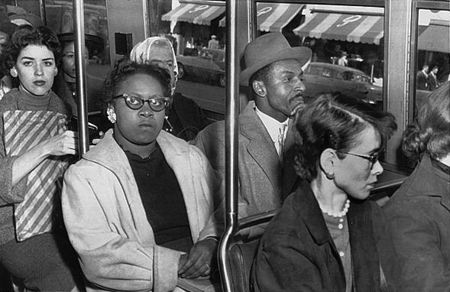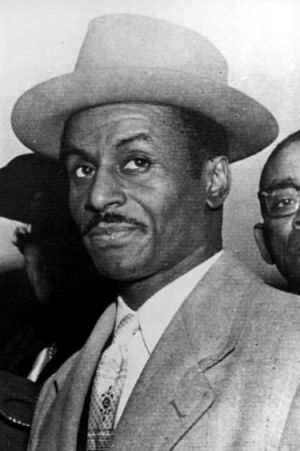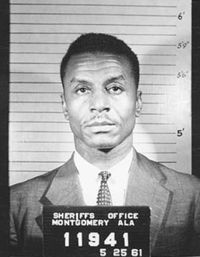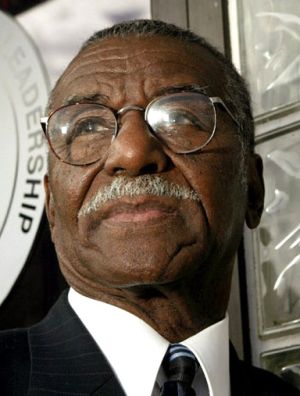Fred Shuttlesworth
Fred Lee Shuttlesworth (born Freddie Lee Robinson March 18, 1922 in Mt Meigs, Montgomery County; died October 5, 2011 in Birmingham) was pastor of Bethel Baptist Church, a founder of the Alabama Christian Movement for Human Rights and the Southern Christian Leadership Conference, and a tireless leader of Birmingham's Civil Rights Movement. He moved to Cincinnati, Ohio in 1961, commuting back to Birmingham for his ACMHR duties. He returned to Birmingham in 2007, following his retirement from the pulpit and a stroke.
Early life

Shuttlesworth was born in the community of Mt. Meigs, in Montgomery County, one of two children born to Alberta Robinson and Vetter Greene, whom she never married. She married William Nathan Shuttlesworth in 1927, giving his name to her children and moving with him to Oxmoor, where he had a small farm. Fred attended Oxmoor Elementary School where he was taught by Israel Ramsey. He entered high school at Wenonah High School, but transferred to Rosedale High School before graduating in 1940. He was arrested for operating a still that August and sentenced to two years' probation.
In 1941, Shuttlesworth married nurse Ruby Keeler. The couple moved to Mobile a year later, where he took a job as a truck driver at Brookley Air Force Base and started studying to become a mechanic. Their first child, Patricia, was born in 1943. The Shuttlesworth's had three more children, Ruby Fredericks in 1945, Fred Jr in 1947, and Carolyn in 1949.
Shuttleworth's pastor at Corinthian Baptist Church in Mobile, E. A. Palmer, encouraged him to enter Bible college at the Cedar Grove Academy in Pritchard. After a positive experience delivering a sermon at Selma University, he decided to follow the call to preaching. He enrolled at Selma and began his ministry in July 1948 at Everdale Baptist Church there. Palmer ordained him in August of that year.
Shuttlesworth completed his bachelor's degree at Selma University in 1951 and went on to get a second degree in English from the Alabama State Teachers College in Montgomery, which he completed in 1953. Later that year he returned to Birmingham to accept the pastorate of Bethel Baptist Church, where he soon became a leader in the emerging campaign by African Americans to secure fundamental civil rights.
Civil Rights campaign
Shuttlesworth entered the Civil Rights fray by presenting petitions to the Birmingham City Commission asking them to hire black officers to the Birmingham Police Department. He was the main speaker at the January 1956 "Emancipation Rally" sponsored by the National Association for the Advancement of Colored People.
On February 3, 1956, Shuttlesworth accompanied Autherine Lucy and her attorney, Arthur Shores, as Lucy became the first black student to enroll at the University of Alabama. At the time, Shuttlesworth was working as the membership chairman for the Alabama chapter of the NAACP. On May 26 of that year, the NAACP was barred by state law from continuing to operate in Alabama, so Shuttlesworth led a group of ministers that founded the Alabama Christian Movement for Human Rights to continue that work. The new group was launched at a mass meeting at Sardis Baptist Church on June 5 with over 1,000 people in attendance.
In December 1956 the United States Supreme Court ruled that racial segregation on buses in Montgomery was illegal. He announced that the ACMHR would test Birmingham's enforcement of similar segregation laws the day after Christmas.
House bombed
On the night of December 25, his house was bombed. Though he was blown into the basement, he and his family and guests were unharmed. His miraculous survival affirmed his sense of duty to lead and earned a measure of awe from his followers. The next morning, he led a group of 300 demonstrators who boarded Birmingham busses. He filed a suit against the city after 22 of the demonstrators were arrested and fined. Commissioner of Public Safety Bull Connor instructed Police Chief Jamie Moore that Shuttlesworth should be subjected by investigators to a lie detector test, "to clear up some rumors that have been circulating." Shuttlesworth issued a response that he would agree to the test if Connor would, "submit to a lie test concerning his KKK sympathies, graft and corruption in the Birmingham PD, Connor's participation in bombings, and whether Connor encouraged police brutality.
SCLC
On February 14, 1957, Shuttlesworth joined Martin Luther King Jr, Ralph Abernathy, and several other Southern religious leaders in forming the Southern Christian Leadership Conference on Transportation and Nonviolent Integration. He was installed as the secretary of the group, a position he held for 12 years. On March 6, Shuttlesworth and his wife challenged the segregation of the Birmingham Terminal Station by using the waiting room reserved for whites.
In May, Shuttlesworth expressed his vision of the spiritual movement for righteousness, paraphrasing the hymn "Lift Every Voice and Sing," in a speech given to a gathering of black ministers in Washington D.C.: "We have arisen to walk with destiny, and we shall march till victory is won. Not a victory for Negroes, but a victory for America, for right, for righteousness. No man can make us hate; and no men can make us afraid. ... and let History, and they that come behind us, rejoice that we arose in strength, armed only with the weapon of Love..." (Manis-1999, p. 136)
By June, Shuttlesworth began to fear that the impetus behind the movement was faltering into a defensive stance. In responding to an invitation from King to attend an SCLC meeting on August 8, he wrote: "It appears that the Southern counter-offensive has all but stymied our progressive attacks upon Fortress Segregation. I would certainly hope that we would never be found fighting as our enemies expect; that is, as they plan for us to fight. And I fervently pray that most of all, we shall never be found fearing to begin. It is my conviction that it is our duty and right to move courageously against Segregation: to attack it rather than waiting to defend ourselves; it is the problem of others to defend it if they can." (Letter to Reverend M. L. King Jr, July 27, 1957)
Beating
In September 1957, Shuttlesworth was badly beaten by a crowd while he attempted to enroll two of his daughters, Patricia and Ruby (nicknamed "Ricky"), at Phillips High School. Recovering from the blows of bats and bicycle chains at University Hospital, he pledged that attempts to integrate the schools would continue the very next day.
Freedom Rides
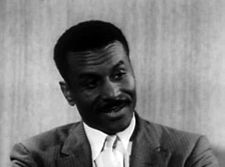
Shuttlesworth supported the Freedom Riders from the Congress for Racial Equality in several ways during their 1961 campaign: Tipped off about the likelihood of violent receptions in Birmingham, he alerted authorities and the press to the need for police protection. He organized a group of drivers to rescue injured riders in Anniston and bring them to University Hospital in Birmingham. He opened his home to riders as a safe-house when violence broke out in the city on May 14. And he was arrested and charged with interference when he attempted to join a group of Nashville students for a follow-up ride to Montgomery on May 20.
Court cases
By 1965, Shuttlesworth was recognized as having brought more suits which reached the U. S. Supreme Court than any other person. He filed suits against the City of Birmingham and the State of Alabama for enforcing segregation laws and for passing and enforcing laws intended to silence him and his supporters. Most of his actions were supported by the NAACP's legal defense fund with help from local movement supporters.
Organization
Over the next few years the movement was active in petitioning for the removal of segregation laws and filing lawsuits to protect the civil rights of African American citizens. Funds to support these activities were raised at mass meetings, held weekly on Monday evenings in churches all across the city. The activities of the ACMHR were dogged by intimidation from the Ku Klux Klan. The Monday meetings were regularly attended by officers of the Birmingham Police Department, who transcribed the speeches. Additional meetings were held during critical moments of action. Bombings increased in frequency at homes, churches and synagogues.
Shuttlesworth's national reputation was climbing, as well. In 1958 he began writing a weekly column for The Pittsburgh Courier, a national black newspaper. He was named in a libel suit against the New York Times in 1960 and was ordered to pay $500,000 in damages. His private car was confiscated. A Supreme Court decision in the countersuit, "New York Times Co. v. Sullivan", reversed his conviction four years later.
In 1961 Shuttlesworth helped to organize the Alabama leg of the Freedom Rides, initiated by the Chicago-based Congress for Racial Equality. A Greyhound bus carrying Freedom Riders was torched in Anniston. A violent mob met the arrival of a bus in Birmingham on May 14 and badly injured several activists. Commissioner of Public Safety Bull Connor indicated that police were not available to dispel the violence due to the Mother's Day holiday.
On August 1, 1961 Shuttlesworth moved to Cincinnati to accept the pastorate of Revelation Baptist Church. Churches in several midwestern cities had competed for his services and the tripling of his salary allowed him to pay for his children to enroll in college. The safety of his family must also have been at issue as the movement was under siege by violent and well-connected racists. He chose Cincinnati in part because daily air service would allow him to continue leading the ACMHR in Birmingham and to guide the pursuance numerous federal lawsuits he initiated.
In 1962 he accompanied King and others to a meeting with Vice President Lyndon Johnson and Attorney General Robert Kennedy, asking them to lead the way in ending racial segregation. The meeting was inconclusive.
Shuttlesworth grew impatient with Reverend King leading up to the 1963 demonstrations. Since 1959 Shuttlesworth had prevailed on King and the SCLC to come to Birmingham to make a true stand against segregation. His letters to King took a challenging tone, warning that "flowery speeches" were needed less than "the hard job of getting down and helping people." In the wake of Governor George Wallace's inauguration pledge to preserve segregation in Alabama "forever"; and following King's failed Albany campaign where city leaders defused the protests by working with moderate Black leaders; the SCLC accepted Shuttlesworth's invitation to come to Birmingham to lead direct action which would force the city's hand.
Project C
Shuttlesworth termed the Spring 1963 demonstrations Project C for "confrontation". Knowing that if the conflict came to a head, the city -- and the nation -- would either have to side with integration, or with Bull Connor, the SCLC led a campaign of non-violent mass demonstrations.
Perceiving what was at stake, business and civic leaders had already put the wheels in motion to remove Connor and roll back the most oppressive segregation ordinances and practices. In fact, he had lost the mayoral election to moderate Albert Boutwell just days before. A group of ministers publicly expressed their sympathy for victims of injustice while pleading for patience and submission while they negotiated for a peaceful resolution. Their Call for Unity, published in The Birmingham News became the framework on which King, jailed on Connor's orders for violating the city's parade ordinance on April 12, 1963, constructed his eloquent and persuasive Letter from Birmingham Jail.
The demonstrations, which had started in earnest with sit-ins at downtown lunch counters, continued. Shuttlesworth led a march to Birmingham City Hall to petition for civil rights on April 6, but was blockaded by police who arrested the marchers after they knelt to pray. A state court issued an injunction specifically prohibiting the group from continuing to demonstrate. Connor vowed to jail as many people as broke the law. Members of the movement voted to continue in defiance of the law and not to stop until their demands were met. The game was set and Shuttlesworth joined King and Ralph Abernathy, clad in work clothes, on the April 12 march which led to King's incarceration. In the days following, hundreds of demonstrators were jailed. Shuttlesworth filed another suit against the city claiming that the parade permit was denied for unconstitutional reasons and that his arrest was, therefore, illegal. The United States Supreme Court found in his favor in 1969.
In early May, children joined the demonstrations. Teenage students were recruited to march, but younger children demanded to be able to participate. They, too, are herded off to jail. In early May, with the jails packed full, Connor ordered fire hoses and police dogs used to contain the demonstrators. While the movement still insisted on non-violent protest, the escalation in tactics touched both sides and threatened to break open. On May 8 firemen knocked Shuttlesworth off his feet in front of 16th Street Baptist Church, which was a rallying point for daily marches. He was hospitalized for a bruised rib.
Truce
In the meantime, the SCLC and City officials, with help from representatives of the U. S. Department of Justice, reached a truce. The ACMHR was not formally represented at the negotiations and Shuttlesworth vociferously demanded additional terms. A new settlement was reached two days later, which he outlined at a press conference in the courtyard of the A. G. Gaston Motel. While Shuttlesworth, still weak from his injury, adjourned from the event, even collapsing on the way out, King continued to speak of the great victory for democracy that was accomplished in Birmingham.
The following Saturday an outburst of bombings and arsons occurred, including a pair of blasts at the Gaston Motel. Leaders on both sides pleaded for peace, but tensions continued to rise during the summer leading up to the first year of integrated schooling in Birmingham. Shortly after school started, a bomb exploded at 16th Street Baptist Church, killing four girls and touching off a renewed crisis on the streets.
Shuttlesworth continued to play a leadership role demonstrations across the state, including the Selma to Montgomery marches in 1965 that drew national support and ushered in the Civil Rights Act, a true victory for the movement.
Later life
Back home in Cincinnati, Shuttlesworth organized the Greater New Light Baptist Church in Cincinnati's North Avondale neighborhood in 1966 and continued to work actively for social and economic justice for African Americans. He has led protests of public utilities and the Cincinnati Police Department and even led protests in Washington against Reagan-era funding cuts for social services. He separated from his first wife, Ruby, in 1969.
Shuttlesworth became a landlord in the 1970s, at one point owning more than 80 rental units. In 1988 he founded the Fred Shuttlesworth Housing Foundation to assist low-income families with homeownership programs. A series of sexual harassment suits were filed against him, but none went to trial. He filed a countersuit alleging that another housing organization was fabricating the harassment claims, but a federal judge ruled in 1995 that there was no evidence of a conspiracy.
Shuttlesworth served briefly in 2004 as the President of the SCLC, resigning in protest at the organization's "deceit, mistrust and ... lack of spiritual discipline and truth."
In August 2005 Shuttlesworth had a benign brain tumor removed. He retired from the ministry in March 2006 a few days shy of his 84th birthday. Church member Sephira Bailey, a former Cincinnati Public Schools principal, helped nurse him back to health after surgery. They were married later that year.
Shuttlesworth suffered a stroke on September 5, 2007. After spending a few months recovering at a nursing home, he returned to Birmingham for three weeks of therapy at the Lakeshore Rehabilitation Center. He accepted a "Live the Dream Award" from the city in February 2008. He was released from the hospital in April and moved into an apartment in the Watts Building downtown. He died at Princeton Baptist Medical Center in October 2011.
Shuttleworth's four children, Patricia, Ruby, Fred Jr, and Carolyn all went to college and became teachers. He was survived by his second wife and four children: Patricia, Ruby, Fred Jr and Carolyn; along with eleven grandchildren and nine great-grandchildren.
Honors
In 1992 a statue of Shuttlesworth was placed directly in front of the Birmingham Civil Rights Institute, which he helped to create. The Institute created the Fred L. Shuttlesworth Human Rights Award in 2002, honoring him as the first recipient as well as the award's namesake.
F. L. Shuttlesworth Drive, renamed in 1988 is a four mile stretch of Huntsville Road from 27th Street North in Norwood to Erwin Dairy Road near Tarrant. There is also a North and South Fred Shuttlesworth Circle (the former North and South Crescent Avenues) in Cincinnati.
In 1999 historian Andrew Manis published a full-length biography of Shuttlesworth. The book won a Lillian Smith Book Award for writing on racial and social justice and the James F. Sulzby Award for writing on Alabama History.
In 2001 President Clinton awarded Shuttlesworth the Presidential Citizens Medal. In 2008 Birmingham International Airport was renamed the "Fred Shuttlesworth Birmingham International Airport" in his honor. The Birmingham City Council added him to the Birmingham Gallery of Distinguished Citizens in 2010.
In 2011, while Shuttlesworth was hospitalized, his wife, Sephira, requested and received a $20,000 appropriation to her Fred Shuttlesworth Foundation from the Birmingham City Council to fund a "Fred Shuttlesworth Legacy Project" and secure a prominent place of interment. Shuttlesworth's children criticized the request for public funding, arguing that his legacy was already secured through the efforts of the Birmingham Civil Rights Institute.
Shuttlesworth died in October of that year and, following a visitation at the Civil Rights Institute and a funeral service at Faith Chapel Christian Center, was buried at Oak Hill Cemetery.
In 2023 the auditorium at Phillips Academy, in the former Phillips High School building, was named in Shuttlesworth's honor. A mural featuring a large portrait of him was also painted on the side of the Legal Services Alabama building the same year.
References
- "Connor asks Negro pastor to take lie test in bombing." (June 3, 1958) The Birmingham News, p. 1
- "Shuttlesworth Returns Challenge of Connor" (June 4, 1958) Birmingham Post-Herald, p. 1
- Manis, Andrew (1999) A Fire You Can't Put Out: The Civil Rights Life of Birmingham's Reverend Fred Shuttlesworth. Tuscaloosa: University of Alabama Press. ISBN 0817309683
- White, Marjorie Longenecker (1998) A Walk to Freedom: The Reverend Fred Shuttlesworth and the Alabama Christian Movement for Human Rights, 1956-1964. Birmingham: Birmingham Historical Society. ISBN 0943994241
- Branch, Taylor (1988) Parting The Waters; America In The King Years 1954-63. New York: Simon and Schuster. ISBN 0671460978
- Manis, Andrew M. (Summer-Fall 2000) "Birmingham's Reverend Fred Shuttlesworth: unsung hero of the civil rights movement." Baptist History and Heritage. - accessed January 17, 2007
- Curnutte, Mark (January 20, 1997) "In the Name of Civil Rights: The Rev. Fred Shuttlesworth carries on a 40-year fight as the movement's 'battlefield general'." Cincinnati Enquirer - accessed January 20, 2007.
- "The Champion" (November 26, 1965) Time Magazine.
- "Icon's family feuds over finances." (February 16, 2008) The Columbus Dispatch
- Walton, Val (February 19, 2008) "Rev. Shuttlesworth to return to Birmingham for post-stroke therapy." The Birmingham News'
- Garrison, Greg (June 29, 2008) "Legacy, history of civil rights icon Fred Shuttlesworth." The Birmingham News'
- Bryant, Joseph D. (September 30, 2011) "Civil rights icon Rev. Fred Shuttlesworth's children resist foundation." Birmingham News
- Garrison, Greg (October 5, 2011) "Fred Shuttlesworth, Birmingham civil rights legend, dies at 89." The Birmingham News
- Nordheimer, Jon (October 5, 2011) "Fred Shuttlesworth, Birmingham civil rights legend, dies at 89." The New York Times
- Kelly, Mark (October 7, 2011) "Rev. Fred Shuttlesworth: The greatest American." Weld for Birmingham

